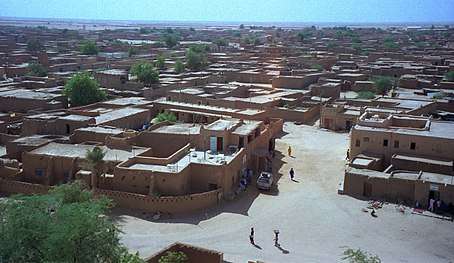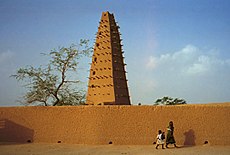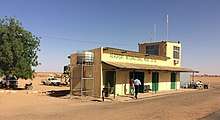Agadez
Agadez, formerly spelled Agadès,[1] is the 5th largest city in Niger, with a population of 110,497 (2012 census).[2] The capital of Agadez Region, it lies in the Sahara desert, and is also the capital of Aïr, one of the traditional Tuareg–Berber federations. The historic centre of the town has been designated a World Heritage Site by UNESCO.
Agadez اغادیز | |
|---|---|
 View of Agadez, from a minaret | |
 Agadez | |
| Coordinates: 16°58′0″N 7°59′0″E | |
| Country | |
| Region | Agadez Region |
| Department | Tchirozerine Department |
| Commune | Agadez |
| Sultanate | 1449 CE |
| Government | |
| • Mayor | Rhissa Feltou |
| Elevation | 520 m (1,710 ft) |
| Population (2012 census) | |
| • Total | 110,497 |
| Official name | Historic Centre of Agadez |
| Criteria | Cultural: ii, iii |
| Reference | 1268 |
| Inscription | 2013 (37th session) |
| Area | 77.6 ha |
| Buffer zone | 98.1 ha |
History
Agadez was founded before the 14th century, and, by growing around trans-Saharan trade, gradually became the most important city of the Tuareg people, supplanting Assodé. The city still sees the arrival of caravans, bringing salt from Bilma.
In 1449 Agadez became a sultanate, but was later conquered by the Songhai Empire, remaining a part of that empire until 1591.[3] At this point, the city had a population of around 30,000 people and was a key passage for the medieval caravans trading between the West African cities of Kano (the source of the Hausa language which is the traditional lingua franca between different ethnic groups in the city, especially in the area of trade, religion and administration) and Timbuktu, and the North African oases of Ghat, Ghadames, and Tripoli, on the Mediterranean shore. Internal fighting led to the gradual decline of the sultanate, and by the mid 19th century the town was a shadow of its former self.[3]
Some contend that Agadez was the furthermost extent of the Ottoman Empire on the African continent until the 19th century, before being occupied by the French colonial empire, though this claim has not been verified by historians.[4] The city was ruled by the French from 1906.[3] A rebellion by Kaocen Ag Mohammed occurred in 1916, but was defeated by French forces.[3] The French, unable to effectively administer this remote region, ruled semi-indirectly via a restored sultan.[3] Later, Agadez became an important location in the Tuareg Rebellion of the 1990s in central and northern Niger.
2007 violence
As a result of the Second Tuareg Rebellion, sporadic violence and the displacement of thousands of people affected the Agadez area from late 2007 into 2009. All of northern Niger was placed on the United States State Department list of areas which are unsafe for travel by United States citizens, covering late 2007 to the end of 2008. Tourist flights to Agadez were suspended by European airlines for the 2007–2008 tourist season (September – March). The burgeoning tourist industry, which prior to 2007 had surpassed that of Niamey and the rest of the nation, essentially came to an end. The entire region was placed under a Nigerien government State of Exception (limiting travel, gatherings, political activities, etc.) in October 2007, renewed through early 2009. Roads to and from Agadez were reported to have been mined, and the government closed the area to international journalists and aid organizations. An unknown number (reported as several thousands) of internally displaced people converged on the city as a result of the unrest.
Immigration towards Europe
In the 2010s Agadez became a major transit town for West African migrants heading to Libya and then on to Europe.[5] Crackdowns in 2016 slowed the flow of migrants, but recent Displacement Tracking Matrix data showed a daily average of 1,212 individuals crossing at six monitored points in Niger,[6] many of whom would have been coming through Agadez.
Demographics
| Year | Pop. | ±% |
|---|---|---|
| 1977 | 20,643 | — |
| 1988 | 49,424 | +139.4% |
| 2001 | 77,060 | +55.9% |
| 2012 | 110,497 | +43.4% |
| source:[7] | ||
Culture and tourism

Today, Agadez flourishes as a market town and as a centre for the transportation of the uranium mined in the surrounding area. Notable buildings in the city include the Agadez Grand Mosque (originally dating from 1515 but rebuilt in the same style in 1844), the Kaocen Palace (now a hotel), and the Agadez Sultan's Palace. The city is also known for its camel market and its silver and leatherwork.
Some well-known musicians from the town include Tuareg guitar player Bombino and his band Group Bombino, and Group Inerane. Mdou Moctar's film, Akounak Teggdalit Taha Tazoughai, is set and filmed on location in Agadez.[8]
Airport and military usage

Agadez's air transport hub, Mano Dayak International Airport, was named after Mano Dayak, the Tuareg leader who is native to the region.
The United States is building Nigerien Air Base 201, a dedicated drone airbase in Agadez from which it can more easily monitor what it calls terrorist activities in West and North Africa, and the Sahel.[9][10] It was revealed in 2016 that the military base in Niger cost the U.S. $100 million.[11]
Climate
Agadez has a hot desert climate (Köppen climate classification BWh).
| Climate data for Agadez, Niger | |||||||||||||
|---|---|---|---|---|---|---|---|---|---|---|---|---|---|
| Month | Jan | Feb | Mar | Apr | May | Jun | Jul | Aug | Sep | Oct | Nov | Dec | Year |
| Record high °C (°F) | 37 (99) |
40 (104) |
41 (106) |
47 (117) |
50 (122) |
46 (115) |
48 (118) |
43 (109) |
41 (106) |
40 (104) |
42 (108) |
40 (104) |
50 (122) |
| Average high °C (°F) | 27.9 (82.2) |
31.1 (88.0) |
35.0 (95.0) |
39.2 (102.6) |
41.3 (106.3) |
41.3 (106.3) |
39.1 (102.4) |
37.9 (100.2) |
38.9 (102.0) |
37.1 (98.8) |
32.4 (90.3) |
29.0 (84.2) |
35.8 (96.4) |
| Daily mean °C (°F) | 19.8 (67.6) |
22.5 (72.5) |
26.7 (80.1) |
31.2 (88.2) |
33.7 (92.7) |
33.8 (92.8) |
32.1 (89.8) |
31.0 (87.8) |
31.7 (89.1) |
29.4 (84.9) |
24.3 (75.7) |
21.0 (69.8) |
28.1 (82.6) |
| Average low °C (°F) | 11.7 (53.1) |
13.9 (57.0) |
18.3 (64.9) |
23.1 (73.6) |
26.0 (78.8) |
26.4 (79.5) |
25.1 (77.2) |
24.2 (75.6) |
24.5 (76.1) |
21.7 (71.1) |
16.2 (61.2) |
12.8 (55.0) |
20.3 (68.5) |
| Record low °C (°F) | −1 (30) |
7 (45) |
6 (43) |
13 (55) |
20 (68) |
19 (66) |
18 (64) |
17 (63) |
18 (64) |
12 (54) |
5 (41) |
−1 (30) |
−1 (30) |
| Average precipitation mm (inches) | 0.0 (0.0) |
0.0 (0.0) |
0.1 (0.00) |
2.0 (0.08) |
5.5 (0.22) |
10.4 (0.41) |
35.2 (1.39) |
49.7 (1.96) |
8.2 (0.32) |
0.3 (0.01) |
0.0 (0.0) |
0.0 (0.0) |
111.4 (4.39) |
| Mean monthly sunshine hours | 297.6 | 280.0 | 294.5 | 288.0 | 297.6 | 270.0 | 288.3 | 285.2 | 285.0 | 306.9 | 303.0 | 294.5 | 3,490.6 |
| Source 1: NOAA[12] | |||||||||||||
| Source 2: Weatherbase[13] | |||||||||||||
Neighborhoods
- Nasarawa, near the Agadez Mosque[14]
- Sabon Gari
- Bariki
- Dag Manet
- Azin
Notes
- "Chisholm, Hugh, ed. (1911). . Encyclopædia Britannica. 1 (11th ed.). Cambridge University Press. p. 442.
- "Annuaires_Statistiques" (PDF). Institut National de la Statistique du Niger. Retrieved 2 May 2013.
- Geels, Jolijn, (2006) Bradt Travel Guide - Niger, pgs. 157-200
- "Ottoman dynasty still alive in Africa - World Bulletin". worldbulletin.net. Retrieved 6 April 2018.
- https://www.theatlantic.com/international/archive/2018/02/niger-europe-migrants-jihad-africa/553019/
- http://www.globaldtm.info/niger/
- Niger: Administrative Division population statistics
- "www.conceptoradio.net/2013/11/13/sahel-sounds-algunos-artistas-africanos-nunca-han-visto-un-vinilo/". conceptoradio. Archived from the original on 31 December 2013. Retrieved 30 December 2013.
- "3 special forces troops are killed and 2 wounded in ambush in Niger". MSN.com. Archived from the original on 5 October 2017. Retrieved 5 October 2017.
- "Pentagon set to open second drone base in niger as it expands operations in Africa". The Washington Post.
- "U.S. MILITARY IS BUILDING A $100 MILLION DRONE BASE IN AFRICA". The Intercept. 29 September 2016.
- "Agadez AERO Climate Normals 1961–1990". National Oceanic and Atmospheric Administration. Retrieved 19 February 2015.
- "Agadez, Niger Weather Averages Summary". CantyMedia. Retrieved 20 April 2016.
- Taub, Ben (10 April 2017). "The Desperate Journey of a Trafficked Girl". The New Yorker. Archived from the original on 3 April 2017.
Most Nigerian brothels in Agadez are in the Nasarawa slum, a sewage-filled neighborhood a short walk from the grand mosque, the tallest mud-brick structure in the world.
References
- Aboubacar Adamou. "Agadez et sa région. Contribution à l'étude du Sahel et du Sahara nigériens", Études nigériennes, n°44, (1979), 358 p.
- Julien Brachet. Migrations transsahariennes. Vers un désert cosmopolite et morcelé (Niger). Paris: Le Croquant, (2009), 324 p. ISBN 978-2-914968-65-2.
- Louis Werner. Agadez, Sultanate of the Sahara. Saudi Aaramco World, January/February 2003. Volume 54, Number 1.
- Samuel Decalo. Historical Dictionary of Niger. Scarecrow Press, London and New Jersey (1979). ISBN 0-8108-1229-0
- Jolijn Geels. Niger. Bradt London and Globe Pequot New York (2006). ISBN 1-84162-152-8.
- Berber Sultanate of Aïr worldstatesmen.org: Chronology of the Berber Sultanate of Aïr, based in Agadez.
External links
| Wikimedia Commons has media related to Agadez. |
| Wikisource has the text of the 1905 New International Encyclopedia article Agades. |

- (in English) Audio interview with Agadez resident about life in Agadez. Great place
- http://www.agadez.org Site covering Northern Niger. Photo Gallery by Michel Batlle "portraits de femmes touarègues"
- interactive Map of the Agadez region.
- https://web.archive.org/web/20161126050447/http://www.agadez-niger.com/ Site covering Agadez and Touareg culture.
- Agadez, the touareg capital of the nigerien region of Air